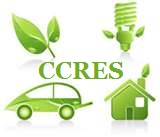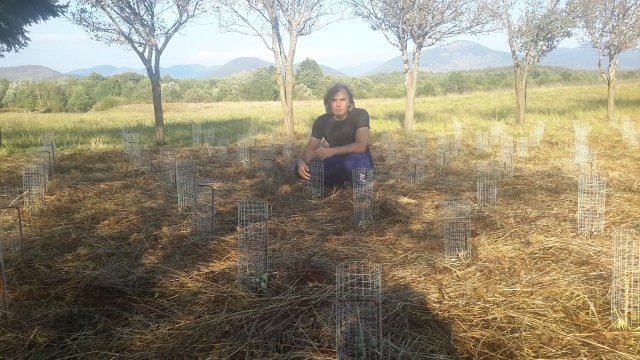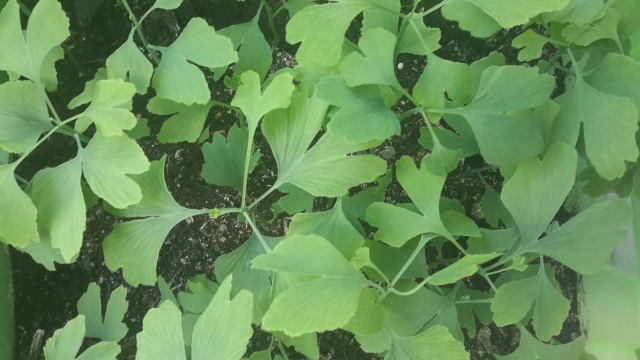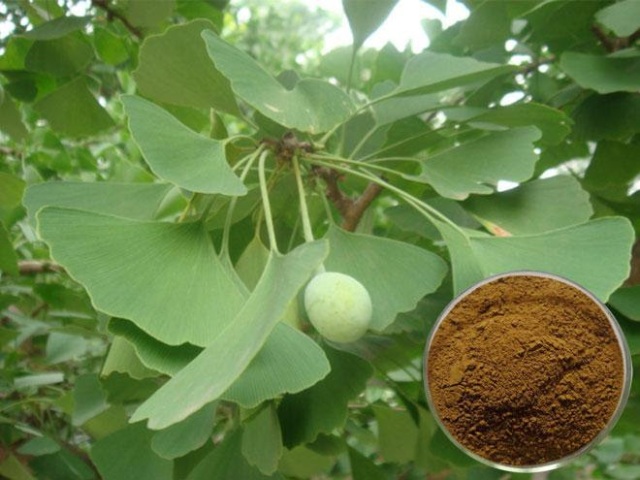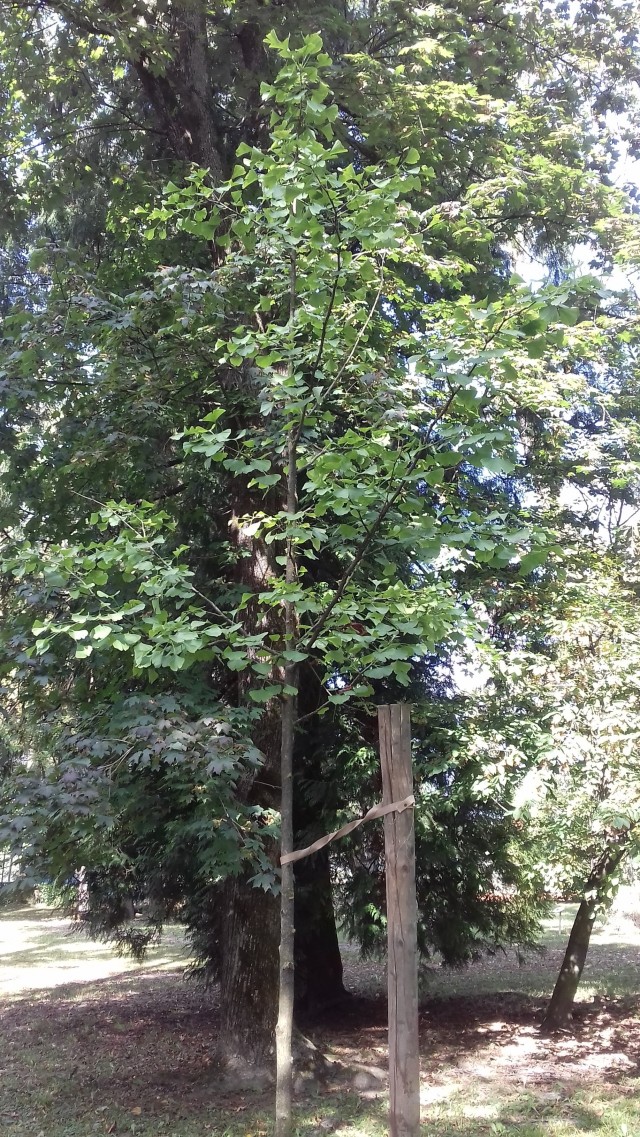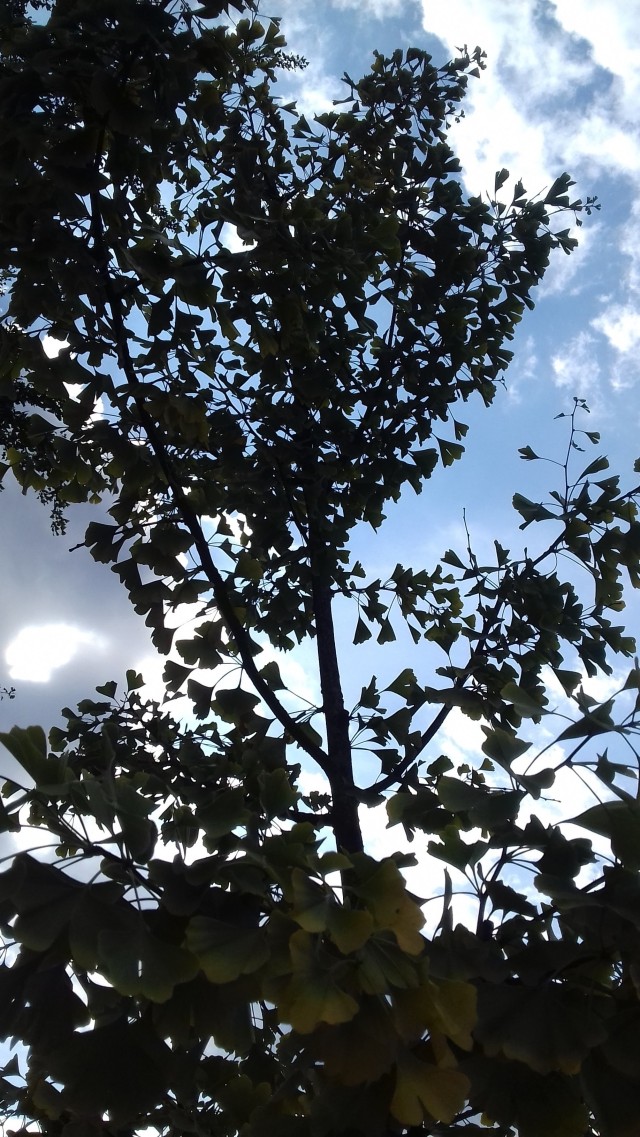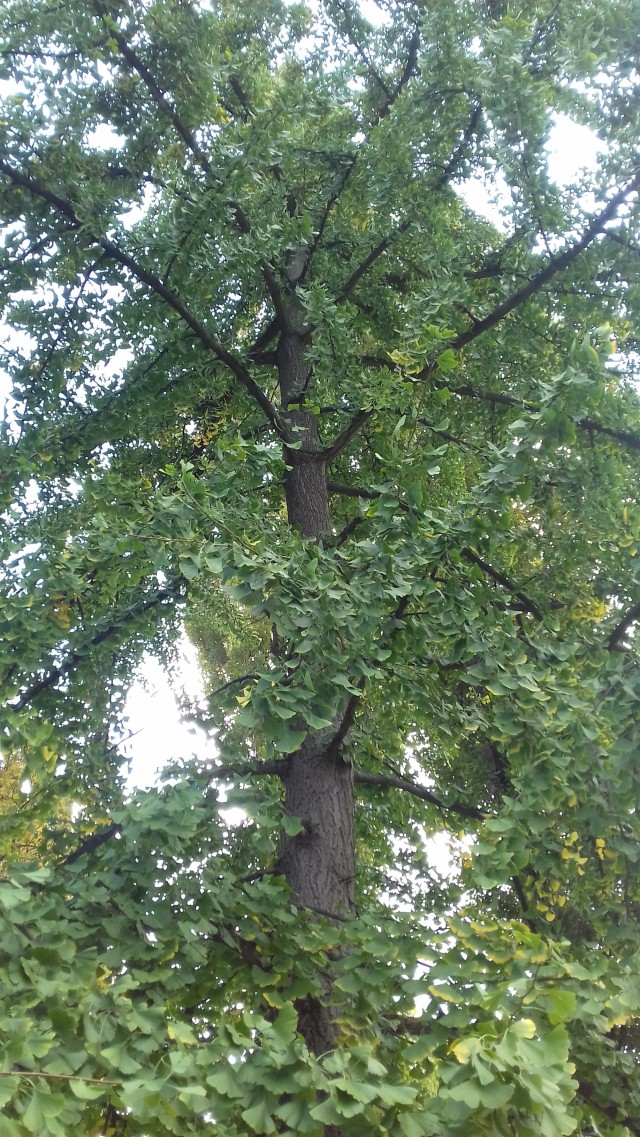ALGAE AND THE ORIGIN OF EUKARYOTIC CELLS
Life began about 3.5 billion years ago in the oceans with the appearance of prokaryotes.
The oldest reliable date for the appearance of the eukaryotes is about 1.9 billion years ago, when the first members of a group of unicellular organisms called acritarchs appear in the fossil record in China.
Acritarchs …
Are probably the remains of a group of ancient eukaryotes
Were plankton
Some resemble dinoflagellates while others resemble green algae
Their relationship among living organisms is uncertain
http://www.ucl.ac.uk/GeolSci/micropal/acritarch.html
http://www.geo.arizona.edu/palynology/ppacrtrc.html
Eukaryotic cells came into existence probably by a process called endosymbiosis.
Mitochondria arose first, as an early eukaryotic cell engulfed but did not digest a bacterium capable of aerobic respiration. The two organisms lived together, one inside the other, and both benefited.
Fungi, plants and animals are all probably derived from protists.
Fungi and animals are eukaryotes organisms that lack plastids.
Another line of evolution, one that had mitochondria, entered another endosymbiosis with a photosynthetic cyanobacterium, which later evolved into a chloroplast.
This line gave rise to algae including green algae, which in turn produced true plants, the embryophytes.
Several clades exist that still have some extant members whose plastids have numerous prokaryotic characters. Chloroplasts of red algae especially resemble cyanobacteria.
The kingdom Protista contains eukaryotes that cannot be assigned with certainty to other kingdoms
The kingdom Protista is an artificial grouping and classification does not represent evolutionary relationships.
This kingdom is also known as Protoctista.
Protists covered in this course are those photosynthetic organisms that function like plants in ecosystems.
They are the “grass of the ocean”.
Protists to be studied include:
Algae: photosynthetic organisms studied by phycologists.
Slime molds and oomycetes: heterotrophic organisms that are traditionally studied by mycologists, although these organisms are not fungi.
Another group of protists not included in this course are the ciliates, flagellates, and other heterotrophs.
The phylogenetic relationship among the different groups of protists is controversial, e.g. the relationship between the green and brown algae.
ORIGIN OF EUKARYOTIC CELLS
DNA Structure
In prokaryotes, proteins do not surround the DNA. Its numerous negative charges are neutralized by calcium ions. In eukaryotes, the DNA is packaged with histones forming nucleosomes. The DNA condenses into chromosomes.
The genome is a short circle of DNA containing about 3,000 genes, and lack introns. In eukaryotes, the DNA molecule carries thousands of genes. The chromosomes of eukaryotes have a homologous and never occur as a single chromosome in normal circumstances. Eukaryotic genes have introns, which do not code for any type of RNA.
Nuclear structure and division
Prokaryotic cells lack nucleus. The DNA circle is attached to the plasma membrane. As the cell grows and the plasma membrane expands, the two daughter DNA molecules are separated.
The nuclei of plants, animals and fungi are very similar in structure, metabolism, mitosis and meiosis. Apparently these three clades diverged after the nucleus had achieved a high level of complexity.
In eukaryotes, most of the DNA is found in the nucleus.
The nucleus is surround by two double-layered membranes with nuclear pores.
A nucleolus is present.
The nuclei are typically haploid or diploid. Mitosis assures that each daughter cell receives one of each type of chromosome to maintain the species number of chromosomes.
Meiosis usually occurs as part of sexual reproduction. The pairing of paternal and maternal homologous chromosomes, followed by crossing over and genetic recombination assures genetic diversity.
Some groups of organisms have a unique mitotic process that may represent an earlier divergence in the history of eukaryotes.
Organelles
Prokaryotes lack membrane bound organelles. They have ribosomes and storage granules, which are not-membrane bound organelles.
Photosynthetic prokaryotes have folded plasma membrane that projects into the cytoplasm.
Eukaryotes have membrane bound organelles that compartmentalize the cell and perform different functions simultaneously.
Ribosomes of prokaryotes are 70S, being smaller and denser than the 80S ribosomes of eukaryotes.
Flagella and cilia are uniform in eukaryotes having a 9 + 2 arrangement of microtubules. A few prokaryotes have flagella, and never have the 9+2 arrangement. They are not composed of microtubules or tubulin.
Endosymbiotic Theory.
This hypothesis attempts to explain the origin of eukaryotic organelles, mitochondria and chloroplasts.
In 1905, K. C. Mereschkowsky had speculated that plastids were prokaryotes living inside eukaryotic cells.
In the 1960s, plastids and mitochondria were discovered to have their own DNA and ribosomes, both with prokaryotic features.
Plastids and mitochondria divide similarly to prokaryotes.
They lack microtubules.
Their DNA is small and circular, contains a small number of genes, and is organized like prokaryotic DNA.
Their ribosomes are sensitive to the same antibiotics that interfere with prokaryotic ribosomes.
Chloroplasts and mitochondria could have originated from bacteria that were phagocytized by a large heterotrophic prokaryote.
Mitochondria could have derived from an aerobic prokaryote that was ingested but not digested.
Chloroplasts could have been derived from a photosynthetic prokaryote, probably a cyanobacterium.
Chloroplasts originated several times.
An endosymbionts is an organism that lives within another dissimilar organism.
These bacteria were then adopted as endosymbionts rather than being digested.
With time these endosymbionts became simplified and specialized to perform only photosynthesis or respiration.
The DNA of the endosymbionts and many or its functions were transferred to the nuclear DNA.
The nuclear membrane could have originated from an infolding of the plasma membrane of a prokaryote.
Prokaryotes have their single circular chromosome attached to the plasma membrane.
Infolding of other portions of the plasma membrane may have given origin to the ER and Golgi complex.
Primary endosymbiosis gave rise to a clade containing red algae, green algae and a small group called glaucophytes.
Glaucophyte chloroplasts still produce a thin film of cyanobacterial wall between themselves and the cell.
Red algal chloroplasts have chlorophyll a but not b, and the cyanobacterial pigment phycobilin, organized into particles called phycobilisomes.
Green algal cells do not have traces of bacterial wall or phycobilin, but instead have chlorophylls a and b, and carotenoid accessory pigments, all of which are similar to chloroplasts in true plants.
Chloroplasts have chlorophyll a but not bacteriochlorophyll. This suggests that the cyanobacteria and not photosynthetic bacteria is the ancestor of chloroplasts.
Prochlorophytes are a type of cyanobacteria that have both chlorophyll a and b, and lack phycobilins.
The prochlorophytes Prochloron and Prochlorothryx are closely related to chloroplasts and are thought to have a common ancestor. Prochloron exists as an obligate endosymbiont of marine invertebrates called ascidians.
Secondary endosymbiosis happened when a eukaryote engulfed another eukaryote.
Euglenoids originated when a eukaryote engulfed a green alga. The green alga has become so reduced that only the chloroplast remains.
Heterokonts have two different flagella of different length and ornamentation. They appear to be monophyletic.
One flagellum is long and ornamented with distinctive hairs (tinsels).
The other flagellum is shorter and smooth (whiplash).
Heterokonts are also known as stramenopiles.
Molecular sequence and these unique flagella provide evidence for the close relationship of oomycetes, chrysophytes, diatoms, and brown algae.
They were involved in one or several endosymbiosis with entire cells of red algae.
Heterokonts appear to have diversified and then some entered into secondary endosymbiosis and became photosynthetic, whereas others did not. Lack of chloroplasts in these heterokonts is an ancestral condition.
Pigmented heterokonts may have originated through one or several secondary endosymbioses.
Most pigmented heterokonts have chlorophyll a and c, lack phycobilins, and have four chloroplast membranes instead of two as in red algae, green algae, glaucophytes and plants. Some have the remnant of red alga nucleus called the nucleopmorph, which still contains a nuclear envelope and a few genes.
These cells have four types of DNA; heterokont eukaryotic nucleus, red alga eukaryotic nucleomorph, chloroplast prokaryotic DNA circles, a mitochondrion prokaryotic DNA circles.
Types of cytokinesis
Several types of cytokinesis occur in algae.
Cytokinesis may occur by furrowing or by cell plate formation.
In almost all algae with wall, cytokinesis is similar to that of plants.
In some green algae, the phycoplast consists of microtubules oriented parallel to the plane where the new wall will form, which is perpendicular to the orientation of the spindle.
Embryophytes arose from green algae that divide with a phragmoplast rather than a phycoplast.
CHARACTERISTICS OF VARIOUS GROUPS OF ALGAE
The following notes are base on Raven et al, 8th Edition, and Mauseth.
DIVISION CHLOROPHYTA
Also known as green algae.
A diverse group of about 17,000 species.
Most chlorophytes are aquatic, but some green algae can live on the surface of snow, on tree trunks, in soils, or symbiotically with protozoans, hydras or lichen-forming fungi.
Chlorophytes range in size from microscopic to quite large: unicellular, colonies, branched and unbranched filaments, thalloid.
Green algae have chlorophylls a and b and store starch as a food reserve inside their plastids.
Most green algae have firm cell walls composed of cellulose, hemicellulose and peptic substances.
The flagellated reproductive cells of some green algae resemble that of plant sperm.
Based on studies of mitosis, cytokinesis, reproductive cells and molecular similarities, the green algae have been divided into several classes. Three of these classes will be studied here:
Body construction in Green Algae
Motile colonies: aggregation of unspecialized cells; flagella present: this is considered to be an ancestral condition, a plesiomorphy.
Nonmotile colonies: similar to the motile colonies but cells have lost their flagella; this is considered an apomorphy.
Filamentous body: cells divide transversally, but sometimes producing a branch; some parts of their body may become specialized, e.g. holdfast for attachment.
Membranous body: cell division occurs in two planes forming a sheet of cells.
Parenchymatous body: cell division occurs in three planes; cells are interconnected by plasmodesmata and true parenchyma tissue is formed.
Coenocytic or siphonous body: karyokinesis occurs without cytokinesis resulting in a large multinucleate cell; the cell remains unspecialized.
Life cycles in Green Algae
The alternation of heteromorphic generations in angiosperms can be traced to green algae.
Monobiontic species consists of only one free-living generation. In some, the haploid phase represents the individual; in others, it is the diploid phase.
In dibiontic species, both stages of the alternation of generations are multicellular
The gametophyte is haploid and the sporophyte diploid.
The two phases may be isomorphic (similar) or heteromorphic (different body plan).
Sporophytes produce spores in sporangia (sing. sporangium).
The sporophyte usually produces spores by meiosis, but some by mitosis – these spores are diploid and produce a new sporophyte in a form of asexual reproduction.
Some gametophytes produce spores by mitosis, which develop into new gametophytes – asexual reproduction.
Gametes are produced in gametangia.
Gametes may be isogamous, anisogamous or oogamous.
Cytokinesis in the Chlorophyta
The following notes are based on Raven et al.
The classes Chlorophyceae and Ulvophyceae form a phycoplast during cell division, which is system of microtubules parallel to the plane of cell division.
Nuclear envelope persists during mitosis.
Mitotic spindle forms and then disappears at telophase.
Daughter nuclei are separated by the phycoplast in which the microtubules lie perpendicular to the axis of division.
The role of the phycoplast is presumed to ensure that the cleavage furrow will pass between the two daughter nuclei.
Cytokinesis is by cell plate formation or development of a furrow.
The Chlorophyceae form four narrow bands of microtubules known as flagellar roots, which are associated with the flagellar basal bodies (centrioles) of the flagella.
The Ulvophyceae have a persistent spindle but do not develop a phragmoplast or cell plate.
The class Charophyceae does not form a phycoplast but develop a phragmoplast like land plants.
Formation of a phragmoplast, which is parallel-aligned microtubules and microfilaments at right angles to the forming cell plate, is to generate a guiding and supporting matrix for the deposition of new cell plate.
The phragmoplast is a system of microtubules, microfilaments and ER vesicles that is oriented perpendicular to the plane of division.
It serves in the assembling of the cell plate and the cell wall.
As the cell plate matures in the center of the phragmoplast, the phragmoplast and developing cell plate grow outward until they reach the of the dividing cell. See pages 64-67in Raven et al.
Spindle is persistent through mitosis.
Cytokinesis is by cell plate formation or furrowing, just like bryophytes and vascular plants.
The flagellar root system of microtubules provides anchorage to the flagellum.
The multilayered structure is often associated with one of the flagellar roots.
The type of multilayered structure is often an important taxonomic character.
The flagellar root had multilayered structure of the Charophyceae is very similar to that found in the sperm of bryophytes and some vascular plants.
Class Chlorophyceae
There are approximately 350 genera and 2650 living species of chlorophyceans.
Mostly freshwater species.
They come in a wide variety of shapes and forms, including free-swimming unicellular species, colonies, non-flagellate unicells, filaments, and more.
Cytokinesis may be by furrowing or by cell plate formation.
When flagellate, the flagella are apical and equal in length, and directed forward.
They also reproduce in a variety of ways, though all have a haploid life cycle, in which only the zygote cell is diploid.
The zygote will often serve as a resting spore, able to lie dormant though potentially damaging environmental changes such as desiccation.
Chlamydomonas is motile unicellular chlorophyte.
Two equal flagella.
One chloroplast with a red photosensitive eyespot, or stigma, aids in the detection of light.
Chloroplast has a pyrenoid, which is typically surrounded by a shell of starch.
The cell wall is made of a carbohydrate and protein complex inside which is the plasma membrane; there is no cellulose in the cell wall.
Reproduction is both sexually and asexually.
See the Life Cycle diagram on page 331 in Ravel et al.
Volvox is a motile colony.
The colony consists of a hollow sphere called the spheroid, made up of a single layer of 500 to 60,000 vegetative, biflagellated cells that serve primarily in photosynthesis.
Specialized reproductive cells undergo repeated mitoses to form many-celled spheroids, which are released after producing an enzyme that dissolves the parental matrix.
Sexual reproduction is oogamous.
Chlorococcum is a unicellular, non-motile chlorophyte.
Found in the soil.
Reproduces by forming biflagellated zoospores.
Sexual reproduction happens by the fusion of biflagellated gametes, which fuse in pairs to form zygotes.
Meiosis is zygotic.
Hydrodictyon is a non-motile colony.
The individual cells are cylindrical and initially uninucleated and eventually becoming multinucleated.
The cells form a hollow cylinder.
At maturity, the cells contain a large, central vacuole surrounded by the cytoplasm containing the nuclei and a large reticulate chloroplast with numerous pyrenoids.
It reproduces asexually through the formation of many uninucleated, biflagellated zoospores.
The zoospores are not released but form an arrangement within the parent cell, then lose their flagella and form the components of a mini-net.
Sexual reproduction is isogamous and meiosis is zygotic.
There are also filamentous and parenchymatous Chlorophyceae, e.g. Oedogonium, Stigeoclonium, and Fritschiella.
Class Ulvophyceae
Mostly marine algae with a few representatives in fresh water.
Filamentous septate, filamentous coenocytic (siphonous) or thalloid
Filamentous species have large multinucleate cells separated by septa; some may be netlike others straight chains. They have a netlike chloroplast.
Siphonous algae are characterized by very large, branched, coenocytic cells
Thalloid species have a single nucleus and chloroplast.
Majority has one plane of division, unlike the Ulva with three planes
Spindle and nuclear envelope persist through mitosis.
Flagellated cells may have two, four or many flagella directed forward
Alternation of generations with a haploid gametophyte and diploid sporophyte.
They have sporic meiosis or a diploid, dominant life history involving gametic meiosis.
Cladophora is a filamentous septate ulvophyte.
It forms large blooms in fresh water.
There are both marine and fresh water species of Cladophora.
Each cell is multinucleated and has one single, peripheral, net-like chloroplast with many pyrenoids. Marine species have an alternation of isomorphic generations.
Most of the fresh water species do not have an alternation of generations.
Ulva consists of a two-cell thick flat thallus that may grow up to a meter in length.
It is known as sea lettuce.
Ulva is anchored to the substrate by a holdfast produced by extensions of the cells at its base.
The cells of the thallus are uninucleate and have one chloroplast.
Ulva is anisogamous and has an alternation of isomorphic generations.
Codium and Halimeda are examples of siphonous marine algae.
Very large, coenocytic cells that are rarely septate characterize siphonous algae.
Cell walls are only produced during reproduction.
Siphonous green algae are diploid, with gametes being the only haploid stage.
Halimeda has calcified cell walls.
Examples to study:
Thalloid: Ulva.
Siphonous: Acetabularia, Codium, Ventricaria, Halimeda.
Filamentous septate: Cladophora.
Class Charophyceae
Growth habit may be unicellular, filamentous, colonial or thalloid (parenchymatous).
Considered closely related to plants due to structural, biochemical and genetic similarities.
The orders Coleochaetales and Charales have plant-like characteristics. These include:
Asymmetrical flagellated cells always have two flagella.
Breakdown of the nuclear envelope at mitosis
Persistent spindles or phragmoplast at cytokinesis.
Presence of phytochrome, flavonoids and chemical precursors of the cuticle.
Other molecular features.
Spirogyra is an unbranched, filamentous charophyte.
Found in fresh water, often forming blooms.
Cells uninucleate.
Filaments are surround by a watery sheath.
Chloroplasts one or more, flat ribbon-like with numerous pyrenoids.
Asexual reproduction occurs by fragmentation.
There are no flagellated cells at any stage of its life cycle.
Sexual reproduction takes place through the formation of a conjugation tube.
The cytoplasm of one cells migrates to the other cell and function as isogametes.
A thick wall of sporopollenin surrounds the zygote.
Meiosis is zygotic.
Desmids are a large group of fresh water charophytes.
Lack flagellated cells.
Desmid cells consist of two sections of semi-cells joined by a narrow constriction.
Sexual reproduction is similar to Spirogyra.
Two orders of Charophyceae, the Coleochaetales and the Charales, resemble bryophytes and vascular plants.
They have plant-like microtubular phragmoplast operating during cytokinesis.
They are oogamous and their sperm are ultrastructurally similar to those of bryophytes.
Morphological and molecular studies indicate that an early basal split in the green algae gave rise to a chlorophyte clade containing most of the green algae, and a streptophyte clade that includes the Coleochaetales and Charales, zygnematalean green algae, and land plants (bryophytes and vascular plants).
Coleochaetales
Include branched filamentous and discoid genera.
Growth occurs at the apex or peripheral cells, and the plant is anchored in mud or silt by translucent rhizoids.
Coleochaete has uninucleate vegetative cells that each contains one large chloroplast with an embedded pyrenoid.
It reproduces asexually by zoospores that are formed singly within cells.
Sexual reproduction is oogamous.
The zygotes remain attached to the parental thallus, which stimulate the growth of a layer of cells that covers the zygotes.
These parental cells have wall ingrowths are believed to function in nutrient transport between gametophyte and sporophyte.
Charales
The thallus in some stoneworts is encrusted with white lime, giving a crusty texture (hence the name brittlewort).
The Charales exhibit apical growth.
The thallus is differentiated into nodal and internodal regions.
The nodal regions have plasmodesmata.
Sperms are produced in multicellular antheridia.
Eggs are produced in oogonia enclosed by several long, tubular, twisted dells.
Sperms are the only flagellated cells in their life cycles.
Zygotes are surround by sporopollenin.
Examples to study:
Filamentous: Spirogyra, desmids.
Thalloid: Coleochaete.
Branched filamentous: Chara
Division Rhodophyta
Red algae are mostly marine organisms found in tropical and warm waters. Fewer than 100 species occur in fresh water. Some occur in cooler regions of the world.
Many species are found in very deep water.
There are 4100 to 6000 known species.
Red algae are mostly structurally complex multicellular organisms with very few species unicellular or microscopic filaments.
They may grow attached to the substrate, submerged vegetation and a few are free floating.
Unique Features Of Cells
Their cell wall lack plasmodesmata but they have pit connections. It is not known if these pits are used for intercellular transport.
Red algae do not produce flagellated cells, and lack centrioles.
Most red algae cell walls are made of cellulose microfibrils that are densely interwoven and are held together by mucilage.
The mucilage is a sulfonated polymer of galactose such as agar and carageenan.
Some species called coralline algae, deposit CaCO3 in their walls.
Coralline algae play an important role in coral reef building.
Many produce toxic terpenoids that deter herbivores.
Food reserves are stored as floridean starch in granules.
Floridean starch resembles glycogen.
Chloroplasts are reddish (rhodoplasts) and contain chlorophyll a, α and β-carotene, accessory water-soluble pigments called phycobilins (phycocyanin, phycoerythrin, allophycocyanin).
These pigments absorb well green and blue-green wavelengths that penetrate deep into the water.
Chloroplast chemicals resemble those found in cyanobacteria and may have originated from this group by endosymbiosis.
Complicated Life Histories
Many reproduce asexually by discharging spores, called monospores, into the water.
All red algae have complex life cycles, reproduce sexually and have no flagellated stages.
Gametophyte, carposporophyte, tetrasporophyte.
The simplest form of sexual reproduction involves the alternation of a haploid gametophyte and a diploid sporophyte.
The gametophyte produces spermatangia (sing. spermatangium) that release nonmotile
The female gamete or egg is produced in the carpogonium, on a same gametophyte.
The carpogonium develops a protuberance called the trichogyne for the reception of the spermatia.
The spermatium fuses with the trichogyne and the nucleus travels to the female nucleus and fuses with it.
The resultant diploid zygote then produces a few diploid carpospores, which are release into the water.
Carpospores produce sporophytes that form haploid spores, which in turn produce new gametophytes.
In some red algae, the zygote produces a carposporophyte generation, which remains attached to the parent gametophyte.
The carposporophyte divides mitotically and eventually produces carpospores.
The carpospores are released and settle onto a substrate, and grow into separate diploid sporophytes.
In many red algae, the diploid zygote is transferred to another cell of the gametophyte called the auxiliary cell where it proliferates into many carpospores.
The carpospores produce a new generation called the tetrasporophyte.
Meiosis occurs I in specialized cells of the tetrasporophyte, called the tetrasporangia.
Each tetraspore germinates into a gametophyte.
Division Phaeophyta
Phaeophytes are also known as brown algae
It is an entirely marine group especially abundant in temperate and cold waters.
Common in the intertidal and subtidal zones; dominant alga of rocky shores.
About 1,500 species.
The Thallus
Size – few are microscopic, most much larger – up to 60 m. Larger forms with complex structure.
There are no known unicellular or colonial representatives of this group.
The simplest form of plant is a branched, filamentous thallus (pl. thalli): a relatively undifferentiated vegetative body.
The thalli range in complexity from simple branched filaments to aggregation of branched filaments called pseudoparenchyma.
Adjacent cells are connected by plasmodesmata without desmotubules connecting the ER.
Pigments
Cells contain numerous disk-shaped, golden-brown plastids that are similar both biochemically and structurally to those of chrysophytes and diatoms.
Chlorophyll a and c (no Chlorophyll b), ß-carotene, fucoxanthin and other xanthophylls.
Food reserves are typically complex polysaccharides, sugars and higher alcohols and sometimes fats.
Glucose and mannitol are polymerized together as laminarin.
Mannitol is a six-carbon sugar-alcohol; it is linked together with glucose in a beta-1,3 linkage.
The principal carbohydrate reserve is laminarin and true starch is absent.
There are two groups based on the presence or absence of pyrenoids.
Kelps
Kelps (Macrocystis and Nereocystis) and rockweeds have a highly differentiated bodies
The walls are made of cellulose and algin, an alginic acid, a long-chained heteropolysaccharide.
Some have stem-like, root-like, leaf-like organs.
Since they do not have vascular systems, these structures are not true stems, roots, or leaves. Termed rhizoid, holdfast, stalk or stipe, and blade.
Kelps have a meristematic region between the stipe and the blade.
Sargassum and Fucus grow from repeated divisions from a single apical cell.
Some species have floatation bladders.
Some free-floating species have lost the holdfast.
Some of the kelps have modified elongated cells in the center of the stipe that are capable of conducting carbohydrates from the blades near the water surface to the lower parts of the alga.
Some brown algae have evolved sieve tubes comparable to those found in food-conducting tissue of vascular plants. These are called trumpet cells.
Sieve tube elements are joined end-on-end by the sieve plates.
Of great economic importance: fertilizer, food especially in Japan, source of algin – stabilizer & moisture retainer in many products such as ice cream, cake frosting, paint, pharmaceuticals, processing of natural and synthetic rubber.
Life Cycle
Their life cycle involves an alternation of generation, and meiosis occurs during spore formation (sporic meiosis).
The ends of the branches are called receptacles and are swollen with large deposits of hydrophilic compounds. Scattered over the surface of the receptacles are small openings that lead to cavities called conceptacles. Gametangia develop in the conceptacles.
The gametophytes of the primitive brown algae produce reproductive structures called plurilocular gametangia. They may function as male or female gametangia or produce flagellated haploid spores that give rise to new gametophytes.
The diploid sporophyte produces both plurilocular and unilocular sporangia.
The plurilocular sporangia produce diploid zoospores that produce diploid sporophytes.
Meiosis takes place in the unilocular sporangia producing haploid zoospores that germinate to produce haploid gametophytes.
Zoospores have tinsel and whip flagella.
Some groups (e.g. Fucus) do not form spores and have a gametic life cycle without alternation of generations.
Phylum Bacillariophyta
An ancient group that appeared in the fossil record about 250 million years ago, and became abundant in the fossil record about 100 million years ago during the Cretaceous.
Diatoms are unicellular or colonial organisms that form an important component of the phytoplankton.
They may count for as much as 25% of the primary production of the earth.
There may be as many as 100,000 species, some of the most diverse and abundant algae on earth.
Diatoms are the primary source of food for many marine animals; they provide essential carbohydrates, fatty acids, sterols, and vitamins to the consumers.
Diatoms live in both freshwater and marine habitats, but are especially abundant in cold marine waters.
Diatoms can also inhabit terrestrial habitats such as damp cliff faces, moist tree trunks and on the surfaces of buildings.
The Walls Of Diatoms Consist Of Two Halves
Cell wall in two parts known as frustules, are made of polymerized silica (SiO2 H2O, 95%) and carbohydrates especially pectin (5%).
The shell is composed of an upper and lower half, with the lower half fitting neatly within the upper, like a Petri dish.
The shell is highly ornamented and perforated with microscopic holes so precisely spaced that they are used commercially to test the resolution of expensive microscope lenses.
These holes connect the living protoplast with the external environment.
Freshwater forms are usually cylindrical in shape: pennate.
Marine species are usually spherical or circular: centric.
Chrysophytes form sometimes “brown blooms” in fresh and salt water.
Diatoms have chlorophyll a and c, and the golden-brown carotenoid fucoxanthin.
Two large chloroplasts are present in pennate diatoms, and many discoid chloroplasts in centric species.
Food is stored in the form of oils and chrysolaminarin, a soluble polysaccharide stored in vacuoles.
Some species are heterotrophic absorbing organic molecules from the environment. Other heterotrophs live symbiotically in foraminiferans.
Fossil frustules make the diatomaceous earths mined for use as filters, insulating material and abrasive polish.
Reproduction In Diatoms Is Mainly Asexual
Reproduction is usually asexual. Changes in the environment or critical small size triggers sexual reproduction.
Yellow-green algae
Some phycologists as a division or class consider the yellow-green algae different from the chrysophytes. Others include them in the chrysophytes.
They have a variety of body shapes: unicellular, filamentous, siphonous or large multicellular body form.
They have chlorophyll c.
Asexual reproduction occurs by isogamy in Vaucheria.
Sexual reproduction consists of biflagellated sperms and a multinucleated egg.
The zygote breaks off and after a period of dormancy germinates forming a new “tube” filled with haploid nuclei.
Division Chrysophyta
Also know as the golden-brown algae.
Chrysophytes are photosynthetic, unicellular colonial organisms; some plasmodia, filamentous and tissue-like forms. About 1000 known species.
Abundant in freshwater and marine environments worldwide.
Chrysophytes contain chlorophylls a and c, and accessory pigment fucoxanthin, a carotenoid.
Cells usually have one or two chloroplasts.
They store food in a vacuole in the form of polysaccharide chrysolaminarin, which is stored in a vacuole usually found in the posterior of the cell.
Some species are heterotrophic ingesting bacteria, algal cells and organic particles.
Some species have cell wall containing cellulose and impregnated with minerals. Others are without walls. One group has silica plates on the cell surface.
Reproduction is mostly asexual by means of zoospores with unequal flagella of similar structure.
Some species can reproduce sexually.
Resting cysts are formed as a result of sexual reproduction at the end of the growing season.
In many ways, golden algae are biochemically and structurally similar to brown algae.
Division Dinophyta
The dinophyta are also known as dinoflagellates.
Molecular evidence indicates that the dinoflagellates are closely related to ciliate protozoa such as Paramecium and Vorticella, and to apicomplexans, a group of parasitic flagellates whose cells contain a non-pigmented plastid, e.g. Plasmodium that causes malaria.
Apicomplexans, dinoflagellates and others form a group called alveolates.
Most are unicellular biflagellates.
About 4000 known species, most of which are members of the marine phytoplankton.
Their flagella beat in two grooves, one encircles the cell and the other extends lengthwise.
The nonmotile dinoflagellates produce flagellated cells that beat in grooves.
Their chromatin is always condensed into chromosomes.
Many are covered with cellulose plates forming a theca.
About half of the dinoflagellates lack photosynthetic apparatus and feed by ingesting food particles or absorbing dissolved organic compounds.
They have chlorophyll a and c, β- and γ-carotenes, a carotenoid called peridinin, fucoxanthin, a yellow-brown carotenoid, and other xanthins..
Some pigmented flagellates carry out photosynthesis and also feed by absorbing carbon compound through a protruded peduncle; this is called myxotrophy.
When dinoflagellates are symbionts, they lack theca, e.g. zooxanthellae of giant clams, corals, worms, etc.
Dinoflagellates store their food as oils and starch.
Under adverse periods of low nutrient levels, dinoflagellates form resting cysts that are carried by currents.
Reproduction is mostly asexual but sexual reproduction has been observed in some species.
Some species produce bioluminescence and powerful neurotoxins that are accumulated by fish and mollusks.
They have a characteristic type of nuclear and cell division.
http://www.ucmp.berkeley.edu/protista/dinoflagellata.html
http://www.ucl.ac.uk/GeolSci/micropal/dinoflagellate.html
http://www.ucmp.berkeley.edu/protista/alveolates.html
http://www.ucmp.berkeley.edu/protista/apicomplexa.html
http://www.nmnh.si.edu/botany/projects/dinoflag/
Phylum Oomycota
Oomycetes is a distinct heterotrophic group of about 700 species.
Unicellular to highly branched, coenocytic and filamentous forms.
Oomycetes are either saprobes or symbionts.
They inhabit aquatic environments: marine, freshwater or moist terrestrial habitats.
Their cell wall is made of cellulose.
Their food reserve is in the form of glycogen.
Asexual reproduction is by means of motile zoospores, which have the characteristic two flagella of heterokonts.
Sexual reproduction is oogamous: one gamete large and nonmotile, the other small and motile.
Eggs are produced in the oogonia.
The antheridium contains many male nuclei.
The fertilized egg forms a thick-walled zygote called the oospore.
The oospore serves as a resting stage during stressful conditions.
Oomycetes are also called water molds, white rusts and downy mildew.
Water Molds Are Aquatic Oomycetes.
Abundant in fresh water.
Mostly saprophytic and a few parasitic including species that cause diseases to fish and fish eggs.
Species may be homothallic or heterothallic.
Saprolegnia and Achlya are common water molds that reproduce sexually and asexually.
Some Terrestrial Oomycetes Are Important Plant Pathogens
Terrestrial oomycetes produce motile zoospores when water is available.
Terrestrial oomycetes are important plant pathogens; the genus Phytophthora is particularly destructive to plants.
They attack important crops like grapes, pineapples, onions, strawberries, apples, citrus fruits, cacao, etc.
Phytophthora cinnamomi killed millions of avocado trees in southern California, and destroyed thousands of hectares of Eucalyptus timberland in Australia.
Phytophthora ramorum was the cause of the disease called “the sudden oak death.” It attacks many species of oaks and also 26 other species of plants including firs and coastal redwoods.
The great potato famine in Ireland (1846) was caused by the oomycete Phytophthora infestans.
A gene has been found in a species of wild potato, Solanum ulbocastanum, from Mexico, that is resistant to potato blight. The resistant gene has now been inserted in the commercial potatoes, Solanum tuberosum.
The genus Pythium attacks and rot seeds in the wild (preemergence damping-off) and seedling (postemergence damping-off)
Before a diatom can undergo mitosis, it must be living in an environment with sufficient silicon to allow it to construct a new shell.
The diploid protoplast undergoes typical mitosis within the shell, and then the two-shell halves separate.
One protoplast gets the top half, and the other gets the bottom half.
In either case, the protoplast then secretes a new “bottom” to the “Petri dish”(i.e., a new half fitting inside the old half).
This means that after every mitotic division, one of the resulting diatoms is smaller than the original. This can go on for several generations.
Eventually, the protoplast inside the tiny shell undergoes meiosis rather than mitosis. Four haploid gametes are released from the shell, which is discarded.
When two gametes meet and fuse, the resulting diploid cell is called an auxospore (zygote).
The auxospore grows into a normal size of the species.
It then secretes a silica case of the original size…and the cycle begins anew.
Sexual reproduction in centric diatoms is usually oogamous, and in pennate diatoms non-motile isogamous.
Division Euglenophyta.
Mostly unicellular fresh water organisms; one colonial genus.
Molecular evidence indicates that earlier euglenoids were phagocytic.
About one third of euglenoids contain chloroplasts; their chloroplasts resemble those of the green algae and suggest that they were formed from endosymbiotic green algae.
About two thirds of the genera are colorless heterotrophs that depend on particle feeding and absorption of dissolved organic compounds.
They are mostly freshwater organisms living in waters rich in organic compounds and particles.
Cell structure:
Cell membrane, with pellicle immediately beneath the membrane.
Lack cell wall; one genus has a wall-like covering made of manganese and iron minerals.
The pellicle is made of protein strips arranged in the form of a helix; it may be rigid or flexible.
Single flagellum for movement coming from the reservoir, and a second non-emergent flagellum.
Flagellar swelling and the stigma or eyespot makes the light-sensing system.
Contractile vacuole used in maintaining water balance.
Pyrenoids are found in chloroplasts. It is a region where rubisco is found and paramylon, a polysaccharide is stored.
Pigments present: chlorophylls a and b, carotenoids and several xanthophylls.
Euglenoids grown in absence of light have been known to lose their chloroplasts and become heterotrophic.
Reproduction in euglenoids is asexual, by mitotic cell division. Sexual reproduction is unknown.
The nuclear membrane remains intact during mitosis in a way similar to the fungi.
About 900 species are known.
An intact mitotic nuclear envelope is probably a primitive condition. The break down of the nuclear membrane is probably a derived condition that appeared after euglenoids separated from the main stack of protists.
http://botit.botany.wisc.edu/courses/botany_130/Diversity/Euglena/Euglena.html
http://www.life.umd.edu/labs/delwiche/PSlife/lectures/Euglenophyta.html
http://www.csupomona.edu/~jcclark/classes/bot125/resource/survey/euglenophyta.html
ECOLOGY OF THE ALGAE
The Ecology of the algae is not found in your textbook.
Algae are dominant in salt and fresh water habitat.
Everywhere they grow, they play a role similar to that of plants in terrestrial habitats.
Along rocky shores, the large and more complex members of the brown, red and green algae grow forming bands that reflect the ability of the seaweeds to withstand exposure.
Seaweeds in this intertidal zone are exposed twice a day to large fluctuations of humidity, salinity and light, in addition to pounding action of the surf and forceful, abrasive water motions.
Polar seaweeds endure months of darkness under the sea ice.
Seaweeds are the food source to a host of herbivores and parasites.
Large beds of seaweeds provide a safe habitat for many aquatic organisms, e.g. kelp beds off the coast of California.
Plankton refers to all suspended drifting organisms found in all bodies of water.
Planktonic algae and cyanobacteria constitute the phytoplankton found in oceans and fresh water.
Heterotrophic plankton and usually swimming microorganisms are called zooplankton.
Bacteria and some heterotrophic protists form the bacterioplankton.
Phytoplankton is found at the base of the food chain.
Colonial and single-celled chrysophytes, dinoflagellates, diatoms and green algae are the most important organisms at the base of the food chain in freshwater habitats.
Unicellular and colonial haptophytes, dinoflagellates and diatoms are the primary producers of the ocean.
In both marine and freshwater habitats, phytoplankton populations are kept in check by seasonal climatic changes, nutrient limitation and predation.
Phytoplankton is the major producers of oxygen in the atmosphere.
Phytoplankton reduces the amount of CO2 in the atmosphere by fixing it during photosynthesis.
Phytoplankton is important in the deposition of CaCO3 deposits on the ocean floor.
The CO2 fixed by photosynthesis and the calcification process is replaced by atmospheric CO2
Several types of multicellular algae are important members of coral reefs and deposit a substantial amount of calcium compound important in coral building.
Some haptophyte protists produce substantial amounts of sulfur oxides that are added to the atmosphere and reflect sunlight helping to maintain a cooler temperature.
CCRES ALGAE TEAM
part of
Croatian Center of Renewable Energy Sources






